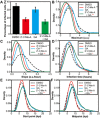More than efficacy revealed by single-cell analysis of antiviral therapeutics
- PMID: 31692968
- PMCID: PMC6821460
- DOI: 10.1126/sciadv.aax4761
More than efficacy revealed by single-cell analysis of antiviral therapeutics
Abstract
Because many aspects of viral infection dynamics and inhibition are governed by stochastic processes, single-cell analysis should provide more information than approaches using population averaging. We have developed a microfluidic device composed of ~6000 wells, with each well containing a microstructure to capture single, infected cells replicating an enterovirus expressing a fluorescent reporter protein. We have used this system to characterize enterovirus inhibitors with distinct mechanisms of action. Single-cell analysis reveals that each class of inhibitor interferes with the viral infection cycle in a manner that can be distinguished by principal component analysis. Single-cell analysis of antiviral candidates not only reveals efficacy but also facilitates clustering of drugs with the same mechanism of action and provides some indication of the ease with which resistance will develop.
Copyright © 2019 The Authors, some rights reserved; exclusive licensee American Association for the Advancement of Science. No claim to original U.S. Government Works. Distributed under a Creative Commons Attribution NonCommercial License 4.0 (CC BY-NC).
Figures





References
-
- Campbell G. L., Marfin A. A., Lanciotti R. S., Gubler D. J., West Nile virus. Lancet Infect. Dis. 2, 519–529 (2002). - PubMed
-
- Peiris J. S., Lai S. T., Poon L. L., Guan Y., Yam L. Y., Lim W., Nicholls J., Yee W. K., Yan W. W., Cheung M. T., Cheng V. C., Chan K. H., Tsang D. N., Yung R. W., Ng T. K., Yuen K. Y.; SARS study group , Coronavirus as a possible cause of severe acute respiratory syndrome. Lancet 361, 1319–1325 (2003). - PMC - PubMed
-
- Burt F. J., Rolph M. S., Rulli N. E., Mahalingam S., Heise M. T., Chikungunya: A re-emerging virus. Lancet 379, 662–671 (2012). - PubMed
-
- Baize S., Pannetier D., Oestereich L., Rieger T., Koivogui L., Magassouba N., Soropogui B., Sow M. S., Keïta S., De Clerck H., Tiffany A., Dominguez G., Loua M., Traoré A., Kolié M., Malano E. R., Heleze E., Bocquin A., Mély S., Raoul H., Caro V., Cadar D., Gabriel M., Pahlmann M., Tappe D., Schmidt-Chanasit J., Impouma B., Diallo A. K., Formenty P., Van Herp M., Günther S., Emergence of Zaire Ebola virus disease in Guinea. N. Engl. J. Med. 371, 1418–1425 (2014). - PubMed
Publication types
MeSH terms
Substances
Grants and funding
LinkOut - more resources
Full Text Sources

